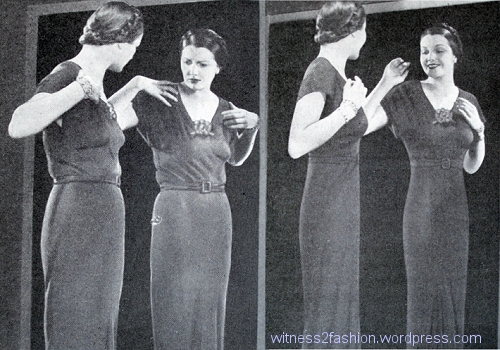
A persuasive ad for Spencer corsets shows a woman wearing the same dress, with and without the corset. Woman’s Home Companion, November 1936. [Of course, photos could be altered with a retouching brush.]

Ads for Spencer custom corsets showed “before,” “after,” and “under” photos; the Spencer corset (center) under a fashionable dress (right). Woman’s Home Companion, Dec. 1936.
The fashions of 1936 and 1937 were designed for very narrow hips.

Left, illustrations of Butterick patterns 6668 and 6605, from February, 1936. Right, holiday party gowns illustrated in Ladies’ Home Journal, January 1936.
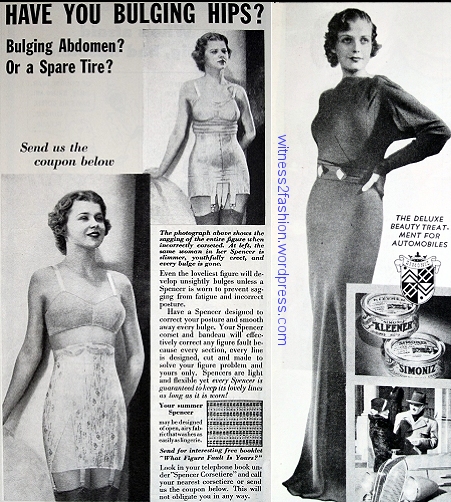
This Spencer corset ad emphasized hip control. January, 1936. The sleek model in the ad for Simonize car polish shows why women were worried about their hip size.
Spencer corsets were made to order, so they were presumably more expensive than ready-made foundation garments.
Another custom corset company, called Spirella, also stressed hip control.
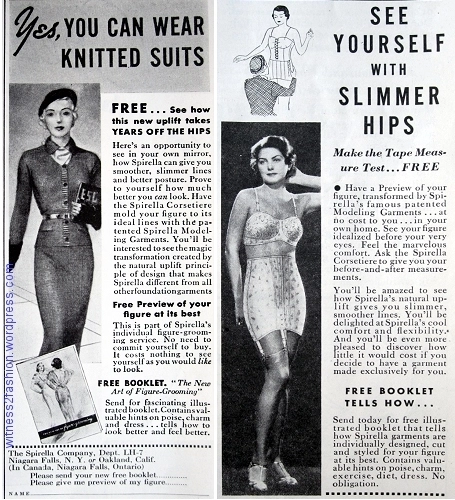
Two ads for Spirella corsets, August and July 1936. Ladies’ Home Journal. “Have the Spirella Corsetiere mold your figure to its ideal lines with the patented Spirella Modeling Garment.” “At no cost to you… in your own home. See your figure idealized before your very eyes.”
Like Spirella, Spencer offered corset fittings in your own house: “Have you ever had a Spencer Corsetiere make a study of your figure? …An intelligent woman, trained in the Spencer designer’s methods of figure analysis will call at your home.”
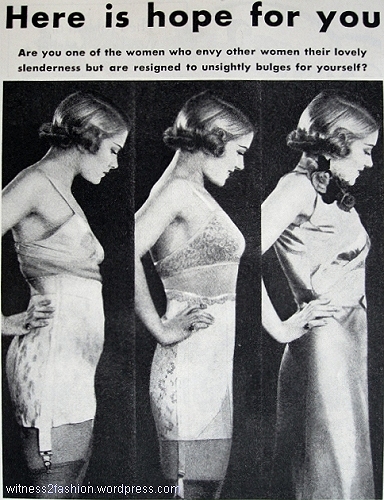
Top image from an ad for Spencer corsets, Woman’s Home Companion, September 1937.
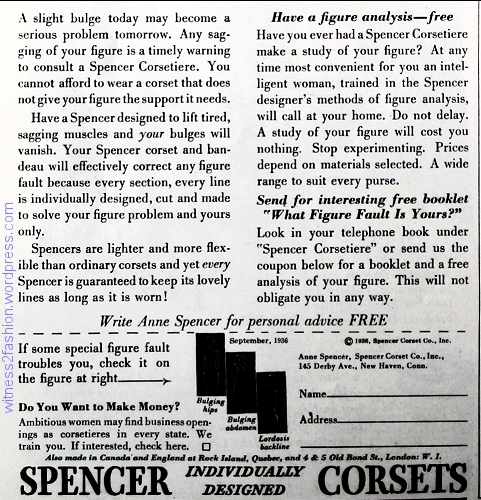
Ad for Spencer corset, Woman’s Home Companion, September 1936.
Just as Listerine warned against “halitosis” to sell mouthwash, this corset ad used “lordosis” — a word which describes the normal curvature of the spine as well as excessive curvature — to sell corsets.

“Figure faults” included “bulging hips,” “bulging abdomen,” and “lordosis.”
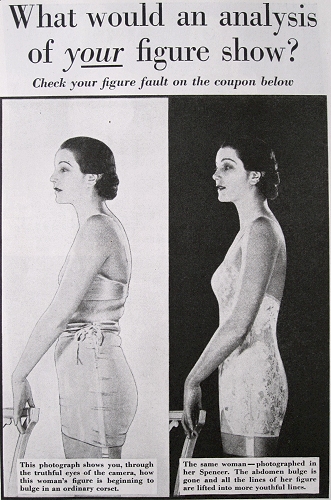
Top of an ad for Spencer corsets, Woman’s Home Companion, September 1936. “Check your figure fault on the coupon below.”
Women were encouraged to identify their “figure fault.”

Spencer Corsets were “individually designed” to correct such “faults” as a normal. curvy derriere.
Notice that the same ad recruited saleswomen who would be trained to become “Spencer Corsetieres.”

Spencer corset ad, April 1937. Notice her flat backside.
Of course, photos can lie; a subtle change of posture — shoulders back, chest up — is noticeable here; but the flattening power of the Spencer foundation garment is also evident.

Corset laces can be seen at the waist of the stretched-out girdle on the left. Spencer ad, WHC, Sept. 1936.
(A flat rear was also important in the 1920’s. Click here.)

The ill-fitting bra and gaping girdle on the left would not enhance the fit of any dress. Spencer ad, Jan 1936.

“Her mirror warned her that her figure was slumping….” Spencer ad, Nov. 1936. WHC.

“But her mirror told a different story when she donned a SPENCER.” Corset ad in Woman’s Home Companion, Nov. 1936.
Pretty persuasive — and the personal fitting was free. A price range was not given; finding out the price from a saleswoman who had already spent time locating your “figure faults” in the privacy of your own home put the buyer in a vulnerable position. But “Your Spencer corset and bandeau will effectively correct any figure fault, because every section, every line is designed, cut and made to solve your figure problem and yours only…. Prices depend on material selected. A wide range to suit every purse.”

Text of a Spencer Corset ad, Woman’s Home Companion, Sept. 1937.
If you’re curious about the Corsetiere’s fitting kit, The Vintage Post has pictures of a Spirella one from the 1940’s. Click here.
These custom corsets were intended for women whose figures were imperfect (or who thought they were.) Women who only needed a little support, or a firmer silhouette, could wear the relatively new elastic foundations like this one from Flexees.

Thanks to Lastex, a one-piece step-in foundation from Flexees smoothed the figure without boning, zippers, hooks and eyes, or lacing. Ad from December, 1936.

oooohhhh! I want one! Much faster than actually exercising and eating right! Thanks for this tip!
bonnie
Well, all of these models were slim to begin with. How would it have worked on someone who was larger?
I wonder if sales would have improved with a typical customer’s before and after? These ads do seem to target a “mature” customer.
I love the fact that they mention that an “intelligent” woman will visit!
Just absolutely no room in those gowns for childbearing hips, secretarial spread, or post lactation bosoms! Oh the tyranny of bias cut satins and knit skirts! That said, the “after” picture in the first ad is truly laughable — that woman’s backside is flat enough to be an ironing board — and I assume LOTS OF AIRBRUSHING happened in that editing room…
Thanks for this post. As always so informative and eye opening!
Some serious photo-manipulation. Fashion advertising has always tried to sell an “ideal” female figure. In the mid-1930’s model measurements 33″-26″-36.”
Hmmm. They sure didn’t draw fashion illustrations to reflect those proportions! 1920s sewing patterns also allowed for hips several inches larger than the bust, but you’d never guess that from the illustrations.
Really interesting. I knew a lot about Spirella and own a few of their corsets.
I wear bias cut 30s dresses regularly and can testify that they are relentless in their exposure of a rounded stomach or xcess bulges anywhere !
I totally understand the attraction of these corsets !
Thank you .
Wow — “ask the woman who owns one” is a good idea but rarely possible. Do your Spirella corsets have laces? Some of the more supportive foundations from the twenties look like their structure would show through a silk gown. I’d love to know more about your collection.
Another well researched article, thank you.
A few comments.
1. I think the target audience for the Spencer ads was women aged 40+ who had lost, and wanted to regain their figures of their youth. As today, clothes for the older woman are modeled by women 10 – 15 years younger. In 1939 These women would have been teenagers before WW1. They were brought up to believe corsets were necessary for all sorts of reasons. Fashion was only part of it. I don’t think this ad was aimed at the younger woman – freedom and comfort were coming into women’s lives.
2. I don’t think the before and after photos have been modified. Fashion photography sells dreams, not reality. Some of the techniques they probably used:
……The before model is looking gloomy and is slumped, the after model and is upright and smiling. “yes, yes, I want to be like the after girl”. They probably used different make up and lighting – hard shadows for the before, soft radiance for the after. It wasn’t only the corset that was different.
…..For the before photo they may have used padding for the bulges and used an ill fitting, worn out, boneless corset. Perhaps a specially made extra, extra firm corset for the after photo. There was no need for the model to be comfortable and she did not need to walk or sit with ease!
…..The photographer would have taken at least 10 or 20 photos of each before and after. Later the choice is made for the most appropriate.
3. I’ve tried wearing a Spirella corset in this style – it certainly takes some getting used to. It’s no good trying to battle against it, the corset is stronger than you.
D
I think you are right about these corsets ads being aimed at a “mature” woman — and I still see modern ads where the model’s posture is the really big change. Thanks for sharing your Spirella experience!
Pingback: “Zip” — Slide Fasteners from Sears, Part 2 | witness2fashion